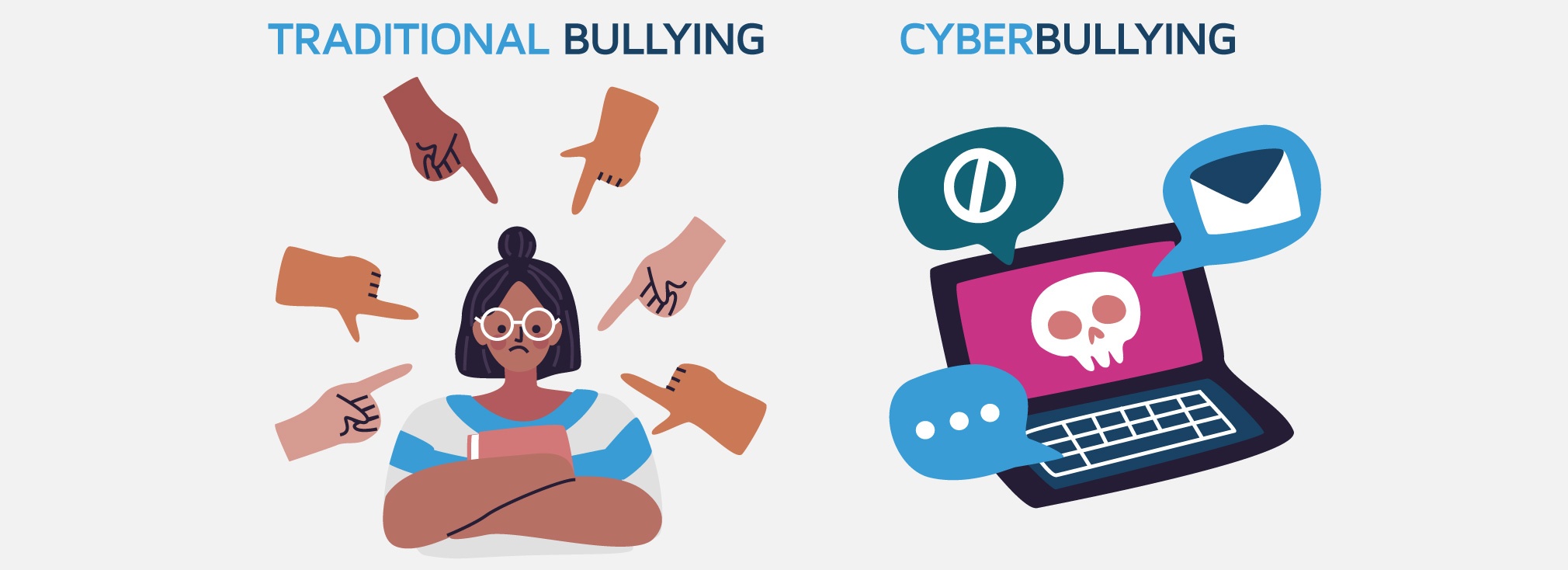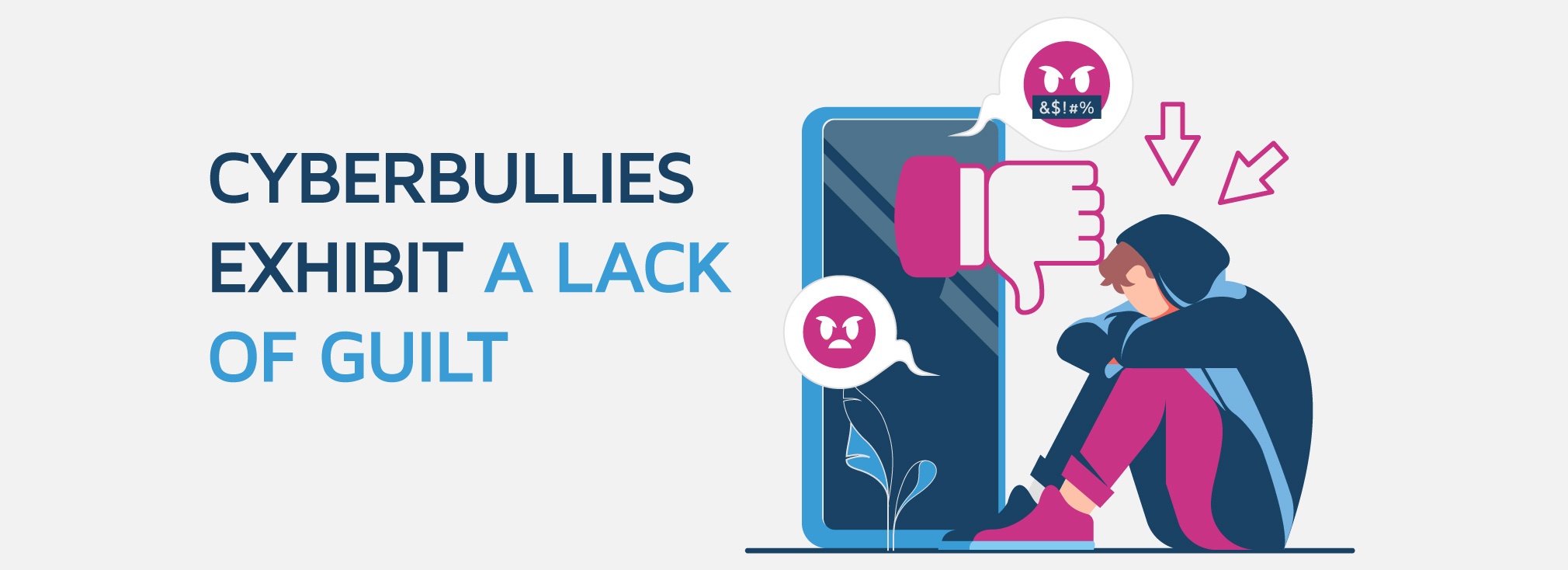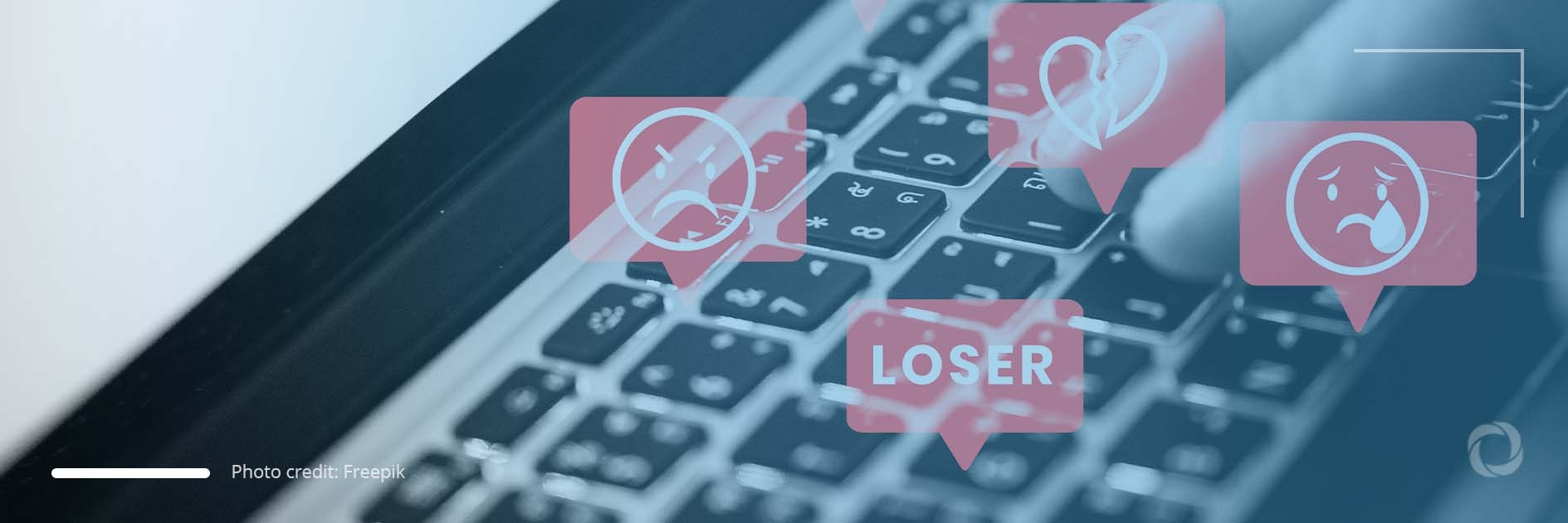Cyberbullying is a form of bullying that takes place via the use of digital technologies. It can happen online (social media or online gaming), via texts, images, and applications where users can engage in or exchange content. Cyberbullying is defined as spreading negative, humiliating, or misleading content about another person.
Cyberbullying vs traditional bullying: what are the main differences?

Although both terms reflect negative and humiliating behaviour, they differ in several ways.
- Cyberbullying means the person abusing has some degree of technological ability
- Cyberbullying allows the bully to remain anonymous
- Cyberbullying harms people with minimal physical interaction
- Cyberbullying has no boundaries – victims can be bullied when at home, via the internet
Where cyberbullying occurs the most
When it comes to humiliating people online, aggressors prefer certain environments that offer the highest level of anonymity and allow room to maneuver.
In cyberspace, bullying occurs via:
- Social media
- Messaging apps
- Comments, chat rooms, message boards
- E-mail messages
- Online gaming groups
According to Dr. Monica Barreto, PhD, a licensed clinical child psychologist at the Orlando Health Arnold Palmer Hospital for Children, the majority of incidents occur on popular social media platforms.
Although social networks allow kids to exchange photos and posts and communicate with friends, they also serve as a breeding ground for cyberbullying. Cyberbullies can make emotionally damaging comments anonymously on these social media networks.
Types of Cyberbullying
Aggressors can bully their targets online in various ways. They can leave insulting comments under a person’s photo or bully someone discreetly in a direct message. These are the most widespread types of cyberbullying:
🔹 Harassment
This typically refers to a continuous and consistent pattern of insulting or abusive online messages sent to a person.
Examples:
- “Warning wars” – many social networks feature buttons to report abuse. Bullies use these buttons to get their target into trouble (to be banned from the site, for example)
- Text wars or attacks – bullies team up to send their victim thousands of texts
- Making unkind or offensive comments about a person
- Posting gossip, threatening or embarrassing content on social media or sending via email
🔹 Impersonation
This involves playing the role of someone else online thereby causing trouble for the real person who is being impersonated.
Examples:
- Altering a person’s profile, adding sexual, racist or other repulsive content
- Coming up with a name that sounds similar to the target’s name in order to publish insulting comments
- Catfishing – the bully creates a fake identity online in order to target their victim
🔹 Photo Shaming
This involves the use of humiliating or inappropriate photos (stolen or taken covertly) of the victim.
Examples:
- Posting naked photos on various online resources
- Sending humiliating images of the victim to numerous people
- Blackmailing a person by threatening to share humiliating pictures of them
- “Slutshaming” – criticism of a person based on their looks, sexual availability, and actual or perceived sexual conduct
🔹 Video Shaming
This involves the use of humiliating or inappropriate videos of the victim.
Examples:
- Cyberbaiting – making the victim become emotional by setting up a certain situation and then filming their behavior. Often the victims are teachers.
- Uploading a humiliating video to YouTube so that a wider audience can see it
- Sending a specific video of the victim to a large number of people via messaging apps
- Using a camera phone to film the bullying of a victim which may include people slapping or kicking their target
What are the main causes of cyberbullying?

According to researchers, cyberbullies exhibit a lack of guilt and have more behavioral issues than those who do not indulge in cyberbullying. This includes being in trouble with the police and skipping school (for certain age groups).
Why do bullies choose to bully and why are they so sure of themselves? The starting point of it all is the willingness of the bully to cross the line when attempting to embarrass other people.
Some of the reasons behind cyberbullying include:
🔹 Lack of compassion
Bullies are usually unaware of the extent of pain they may be inflicting on the other person. This gives them a sense of power.
🔹 “They deserve it”
Cyberbullying is often used to judge people and ‘punish’ them for certain reasons. Such behavior makes bullies feel superior although the so-called ‘punishment’ is not justified.
🔹 The bullied turns into a bully
People who were once victims of bullying may become bullies themselves to vent their anger.
🔹 Out of boredom
Some children are simply bored and thus search for amusement. They will occasionally become cyberbullies to spice up their life with the internet becoming their source of entertainment.
🔹 Fitting in
Youngsters may sometimes cyberbully in order to become part of a certain group of kids they want to hang out with.
🔹 “Everyone does it”
When a person thinks or sees many other people bullying, they are more inclined to engage in the same behavior.
What can be done to prevent cyberbullying?
- Make sure that the child communicates with their real friends and/or those who they actually know.
- Make sure that privacy settings are enabled on all of their social media profiles. To check this, Google their name and if they have a page on social media, it will appear in the search results but if their accounts are set to private, you will not be able to read any postings.
- Make sure your youngster understands the importance of not sharing or disclosing passwords.
- Make sure the person is aware of how to ignore, block, delete or report people bothering them.
- Spread the information about cyberbullying and the methods of dealing with it.
- Report cyberbullying as soon as it takes place.
Fig.1. Percent of 9 to 12-year-olds who were cyberbullied (n=150) who say they stopped cyberbullying by:
Cyberbullying statistics
Fig.2. Percent of 9-to-12-year-olds who say they have ever:
- Youngsters who have suffered from cyberbullying are 12 times more likely to have suicidal thoughts than teens who have not been bullied
- According to a survey of 6195 youngsters aged 10 to 18 conducted between June and August 2020, over half of them have encountered at least one type of cyberbullying in their lifetime
- In 11 EU countries, 44% percent of pupils who had been subjected to cyberbullying prior to 2020 reported being bullied much more during the COVID-19 lockdowns
- In the US, 44% of active internet users had encountered online harassment with 28% claiming severe forms of online abuse such as violent threats and stalking
- According to a 2019 poll published by UNICEF, around 30% of teens in 30 nations have been victims of cyberbullying and 20% of them had skipped school as a result
- According to 2018 research, victims of cyberbullying aged under 25 were more than twice as likely to harm themselves
Cyberbullying is public, ubiquitous and affords the perpetrator anonymity that traditional bullying does not. Statistics consistently show that cyberbullying has harmful outcomes and therefore health care practitioners, parents and children should be educated about how cyberbullying occurs, the harmful things it can do, and how to assist in its prevention.

